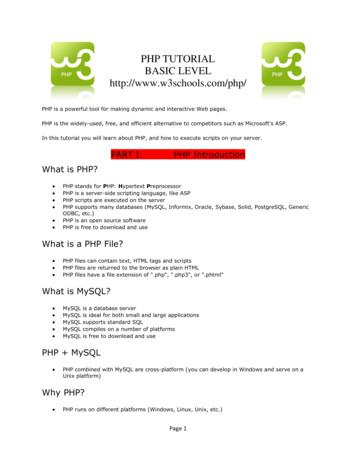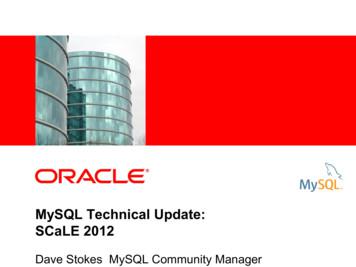Advanced PHP And MySQL - Faith Infosys
COURSE SYLLABUSAdvanced PHP and MySQLIndustrial TrainingPH: 0481 2411122, 09495112288E-Mail: info@faithinfosys.comwww.faithinfosys.com(3 MONTHS)Marette TowerNear No. 1 Pvt. Bus StandVazhoor RoadChanganacherry-01
Target AudienceThis course is specially designed for the B.Tech/B.E, M.Tech/M.E andall other IT related Graduates and Post Graduate students who are interested inlearning web development using PHP framework.MissionProfessionalism has conquered the job scenario and companies seek forwell qualified, professional and skilled manpower. Keeping in view this demandof companies we groom students in such a way that they will be second to none.Quality Education and Performance Oriented Training is our motto.Course OverviewThis course provides the necessary knowledge to design and developdynamic, data-driven & interactive web pages using PHP. It introducesstudents to PHP framework and syntax, most important techniques used to builddynamic web sites and perform hands on practice with a MySQL database tocreate database-driven HTML forms. It is interspersed with step-by-stepexercises illustrating the concepts as they are explained.Live Project WorkLive project is the phase when you finally implement most of the thingsthat you have learnt during your software training. Software development ismore than just coding. Before you write even a single line of code, it requirescareful analysis of the requirements, gathering information, preparing thenecessary documentation which requires understanding the live project usingSoftware Development Life Cycle. So you have to learn tricks to produce bulkoutput on time maintaining the right design quality or coding standard. That isthe significance of Live Project Training. We assure that our Live ProjectTraining will impart the confidence in students to work on real time projects. Add on Programs Faith InfosysPersonality DevelopmentListening SkillsCommunication SkillsInterview SkillsGroup Discussion Topics PresentationAwareness of IT TrendsAptitude TestsTechnical TestsMock InterviewPage 1
SOFTWARE ENGINEERING WITH UMLThis course covers concepts of software engineering. It intends to lay afoundation for software designing and professional practice by conveyingfundamental knowledge about software development process, requirementsanalysis, design techniques, and testing methods. The course emphasizes onmodeling skills with the Unified Modeling Language (UML).Section 1: Overview of Software Development1.1 Software Engineering Concepts1.2 Software Engineering Development Activities1.3 System Development Models and Approaches1.4 Software Process and Project ManagementSection 2: Software Development Life Cycle2.1 Requirement Elicitation2.2 Analysis2.3 System Design2.4 Object Design2.5 Implementation2.6 TestingSection 3: UML3.1 Introduction3.2 Need of UML3.3 Use Case Driven Object Oriented Analysis3.4 Use Case Model3.5 Use Case Diagram3.6 Activity Diagram3.7 Sequence Diagram3.8 Collaboration Diagram3.9 Class DiagramSection 4: Project Development Models4.1 Waterfall4.2 V model4.3 Prototype model4.4 Spiral modelFaith InfosysPage 2
WEB-SCRIPTINGSection 1: HTML5- The Static Web Page Creation1.11.21.31.41.51.61.71.81.9HTML5 IntroductionStructureElementsSemanticsAudio & VideoSection & ArticleCanvas, AsideDrag & DropForms & Form ElementsSection 2: CSS 3 - The Presentation Semantics2.1 CSS Properties, Selectors, Style Declaration Types2.2 Colors, Backgrounds, Text and Fonts2.3 Images, Links, Tables and List2.4 Borders, Padding, Margin2.5 Cursor, Dimension, Scrollbars, Visibility and Positioning2.6 Pseudo class & Elements, @Rules( import, font-face, charset)2.7 Filters, Media Types, Printing and LayoutsSection 3: JavaScript - The Interpreted Programming Language3.1 Interpreted Programming Languages3.2 Integrating JavaScript with HTML3.3 Variables in JavaScript3.4 Operators in JavaScript3.5 Expressions in JavaScript3.6 Arrays in JavaScript3.7 Handling Loops & Decision structures3.8 Executing Conditional statements3.9 Working with FunctionsSection 4: jQuery - Write Less Do More 4.1 Understanding jQuery4.2 jQuery Selectors4.3 Event Manipulation Methods4.4 Sliding, Easing, Fading, Toggling4.5 jQuery and AJAX calls4.6 JSONFaith InfosysPage 3
Section 5: Bootstrap5.15.25.35.45.55.65.75.85.9Introduction to BootstrapBootstrap Grid SystemCreating Layouts with BootstrapBootstrap CSS - Understanding the CSSCSS Customization / SkinsResponsive Web design with BootstrapSingle Page Responsive site with BootstrapBootstrap Layout ComponentsBootstrap Plug-ins : Transition Modal Dropdown Scrollspy Tab Tooltip5.10 Building Websites with BootstrapSection 6: AngularJS6.1 AngularJS Introduction6.2 Single Page Application (SPA)6.3 Directive, Filters and Data Binding What are Directives? Using Directives and Data Binding Syntax Data-Binding Example using AngularJS Directives Iterating with the ng-repeat Directive ng-repeat Example The AngularJS API Reference for Directives Using Filters Using Filters Demo6.4 Views, Controllers and Scope6.5 Modules, Routes And Factories Faith InfosysCreating a ModuleCreating a Controller in a ModuleThe Role of RoutesDefining RoutesDefining Routes DemoUsing Factories and ServicesThe Role of the FactoryPage 4
PROGRAMMING LANGUAGE (PHP-MySQL)Course Description:The contents of this course are a comprehensive solution that moulds youto a PHP specialist by providing a combination of on hand labs and the trainingprovided in the class. It helps the trainee to learn and develop various phptechnology applications that definitely meets the current industry needs.Section 1: PHP – Understanding the Preliminaries1.11.21.31.41.51.61.71.8Introduction to web & internetIntroduction to serverUnderstanding localhost serverStarting PHPPHP syntax and variablesOperators and ExpressionsConditional Branching and Looping StatementsLearning Arrays in PHPSection 2: PHP - The Core Logics and Techniques2.1 String and Math functions in PHP2.2 Introduction HTML Form Elements and Fields2.3 Accessing PHP, HTTP Data2.4 Query Strings and Hyperlinks2.5 Describing Pre-Defined Variables - Super Global Arrays2.6 Understanding Functions, Important PHP Functions2.7 What are the Scope of variables2.8 Usage of Include and require statementsSection 3: PHP – File Handling. The Plain Repository of Data3.1 Handling files and directories in PHP3.2 Fetching information from files3.3 Uploading and downloading filesFaith InfosysPage 5
Section 4: PHP and MySQL - The Structured Repository4.1 PHP MySQL Connectivity4.2 Integrating Web Forms and Database4.3 Using PHP’s MySQL Extension4.4 Using PHP’s PDO ExtensionSection 5: Learn More Advanced Techniques in PHP5.1 Introduction to Object Oriented Programming5.2 Classes and Objects5.3 Abstraction, Encapsulation, Inheritance and Polymorphism5.4 Constructors and Destructors5.5 Overloading, Overriding of functions5.6 Exception Handling5.7 Regular Expressions5.8 Session Handling5.9 Using CookiesSection 6: Working with XML and JSON6.1 Introduction to XML6.2 How to Integrate PHP and XML6.3 Introduction to JSON6.4 Building a Sample Web ApplicationSection 7: Content Management Systems7.17.27.37.47.57.67.7Knowing Content Management SystemSample Web Application Development using WordpressInstall Wordpress On The Mysql DatabaseInstall, and activate a ThemePosts, Pages and MenusUsing Widgets and PluginsCustomizing ThemesFaith InfosysPage 6
Section 8: CodeIgniter Framework8.1 Introduction to PHP Frameworks8.2 Working with CodeIgniter Framework8.3 MVC architecture in CodeIgniter8.4 Routing8.5 Controllers,Views and Models8.6 Helpers and Libraries8.7 FormValidation8.8 FetchingData using Input Class8.9 Session8.10 DatabaseSection 9: Payment Gateway, E-mail and Social Media Networks9.1 Integration of payment gateway9.2 Integrating emails to web application9.3 Integrating social media networks to web applicationSection 10: FTP Management/Web Hosting10.1 Set up a domain and hosting account10.2 Understanding FTP10.3 Setting up FTP Server (Live)10.4 Uploading and downloading FTP contentsSection 11: Web Security11.1 Data Validation11.2 SQL Injection11.3 Cross Site ScriptingSection 12: Search Engine Optimization(SEO)12.1 Onsite Optimization Basics12.2 Coding Best Practices12.3 Title Tag Optimization12.4 Keywords12.5 Meta Tags Optimization12.6 Headers Optimization SEO Content Writing12.7 Page Speed Optimization ToolFaith InfosysPage 7
MySQLSection 1: Relational Database Basics1.1 Brief History of MySQL1.2 Relational Databases and Popular Databases1.3 SQL StatementsSection 2: Data Manipulation Language (DML)2.1 INSERT2.2 UPDATE2.3 DELETE2.4 SELECTSection3: Data Definition Language (DDL)3.1 CREATE3.2 ALTER3.3 DROPSection4: Sub-Queries, Joins and Unions with MySQL4.1 Order By, Like , And & Or, Where , Between4.2 Joins & Unions4.3 Aggregate Functions and GroupingSection 5: Constraints and Normalization5.1 Understanding Primary and Foreign Keys5.2 Understanding Database Normalization5.3 Views and TriggersFaith InfosysPage 8
Live Project (The Mapping of what you learn )A software development process provides a basis for the organizedproduction of software, using a collection of predefined techniques andnotations. The process starts with the formulation of the problem, and thencontinues through analysis, design and implementation.Development Stages:1. System ConceptionConceive an application and formulate tentative requirements. Itdeals with genesis of an application.2. AnalysisAnalysis focuses on creation of models. It specifies what must bedone, not how it should be done. Developers must fully understand theproblem before addressing the additional complexities of design. Duringanalysis developers consider the available sources of information andresolve ambiguities.3. System DesignDuring system design, the developer makes strategic decisionswith broad consequences. The system designer must understand how anew system interacts with other system, and the system must supportfuture modifications4. Class DesignDeveloper expands and optimizes analysis models, there is a shiftin emphasis from application concepts toward computer concepts.Developers choose algorithms to implements major system functions.5. ImplementationImplementation is the stage for writing the actual code.Developers map design elements to programming language and databasecode.6. TestingDuring testing, Testers once again revisit the original businessrequirements and verify that the system delivers the proper functionality.It also uncovers the accidental errors that have been introduced.**********************************Faith InfosysPage 9
Section 4: PHP and MySQL - The Structured Repository 4.1 PHP MySQL Connectivity 4.2 Integrating Web Forms and Database 4.3 Using PHP’s MySQL Extension 4.4 Using PHP’s PDO Extension Section 5: Learn More Advanced Techniques in PHP 5.1 Introduction to Object Oriented Programming 5.2 Classes and Objects
MySQL PHP Syntax MySQL works very well in combination of various programming languages like PERL, C, C , JAVA and PHP. Out of these languages, PHP is the most popular one because of its web application development capabilities. PHP provides various functions to access MySQL database and to manipulate data records inside MySQL database.
MySQL is no longer enabled by default, so the php_mysql.dllDLL must be enabled inside of php.ini. Also, PHP needs access to the MySQL client library. A file named libmysql.dllis included in the Windows PHP distribution and in order for PHP to talk to MySQL this file needs to be available to the Windows systems PATH. See the FAQ titled "How do I add my PHP directory to the PATHon Windows" for .
PHP is FREE to download from the official PHP resource: www.php.net PHP is easy to learn and runs efficiently on the server side Where to Start? To get access to a web server with PHP support, you can: Install Apache (or IIS) on your own server, install PHP, and MySQL Or find a web hosting plan with PHP and
MySQL for Excel is a 32-bit add-in for Microsoft Excel, which you can install and run on Microsoft Windows. MySQL for Excel is not compatible with Linux or macOS. MySQL for Excel can interact with MySQL Workbench to simplify the management of MySQL connections when both MySQL client tools are installed.
Lifetime Support Oracle Premier Support Oracle Product Certifications MySQL Enterprise High Availability MySQL Enterprise Security MySQL Enterprise Scalability MySQL Enterprise Backup MySQL Enterprise Monitor/Query Analyzer MySQL Workbench MySQL Enterprise Edition. 11 MySQL Database
uqc103s/UFCE47-20-1 PHP-mySQL 7 Why PHP and mySQL „ MySQL is a key part of LAMP (Linux, Apache, MySQL, PHP / Perl / Python), a fast growing open source enterprise software stack. More and more companies are using LAMP as an alternative to expensive proprietary software stacks because of its lower cost and freedom from lock-in.
uqc103s/UFCE47-20-1 PHP-mySQL 7 Why PHP and mySQL „ MySQL is a key part of LAMP (Linux, Apache, MySQL, PHP / Perl / Python), a fast growing open source enterprise software stack. More and more companies are using LAMP as an alternative to expensive proprietary software stacks because of its lower cost and freedom from lock-in.
approaches to the subject of reconstruction in archaeological illustration, and other media i.e. films. Method(s) of teaching: The module comprises: A weekly practical session (2hrs) where tutor will introduce different materials and recorded graphic data to be drawn. 1 x lecture Visit and meet with archaeological illustrators and graphic designers in their workplace Method of assessment: The .























